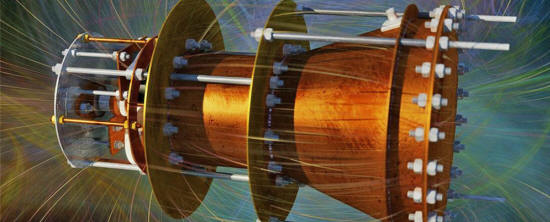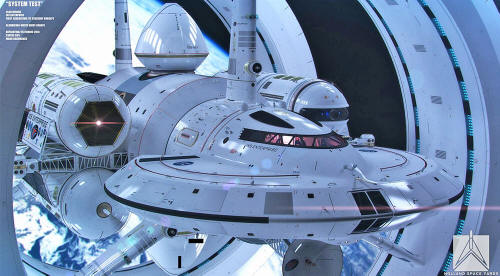|
by Fiona MacDonald
07 November 2016
fuel-less propulsion?
The EM Drive has made headlines over the past year, because it offers the incredible possibility of a fuel-free propulsion system that could potentially get us to Mars in just 70 days.
But there's one major problem: according to the 'current' laws of physics, it shouldn't work.
The issue is the fact that the EM Drive defies Newton's third law, which states that everything must have an equal and opposite reaction. So, according to Newton and our current understanding of the world around us, for a system to produce propulsion, it has to push something out the other way (in space, that's usually combusted rocket fuel).
But the EM Drive works without any fuel or propellants at all.
It works by simply bouncing microwave photons back and forth inside a cone-shaped closed metal cavity. That motion causes the 'pointy end' of the EM Drive to generate thrust, and propel the drive in the opposite direction.
Despite years of testing and debate, the drive remains controversial. The bottom line is that, on paper, it shouldn't work, according to the laws of physics. And yet, in test after test, the EM Drive just keeps on working.
Last year, NASA's Eagleworks Laboratory got involved to try to independently verify or debunk the EM Drive once and for all.
And a new paper on its tests in late 2015 (Measurements of Impulsive Thrust from a Closed Radio Frequency Cavity in Vacuum) has just been leaked, showing that not only does the EM Drive work - it also generates some pretty impressive thrust.
To be clear, despite rumors that a NASA paper on these tests has passed the peer-review process, the version that's been leaked hasn't been published in an academic journal.
So, for now, this is just one group of researchers reporting on their results, without any external verification.
But the paper concludes that, after error measurements have been accounted for, the EM Drive generates force of 1.2 millinewtons per kilowatt in a vacuum. That's not an insignificant amount - to put it into perspective, the super-powerful Hall thruster generates force of 60 millinewtons per kilowatt, an order of magnitude more than the EM Drive.
But the Hall thruster uses fuel and requires a spacecraft to carry heavy propellants, and that extra weight could offset the higher thrust, the NASA Eagleworks team conclude in the paper.
Light sails on the other hand, which are currently the most popular form of zero-propellant propulsion, use beams of sunlight to propel them forward rather than fuel. And they only generate force up to 6.67 micronewtons per kilowatt - two orders of magnitude less than NASA's EM Drive, says the paper.
The NASA Eagleworks team measured the EM Drive's force using a low thrust pendulum at the Johnson Space Centre, and the tests were performed at 40, 60, and 80 watts.
They were looking for any sign that the thrust could be a result of another anomaly in the system, but for now, that doesn't appear to be the case.
But the team does acknowledge that more research is needed to eliminate the possibility that thermal expansion could be somehow skewing the results.
They also make it clear that this testing wasn't designed to optimize the thrust of the EM Drive, but simply to test whether it worked, so further tweaking could make the propulsion system more efficient and powerful.
So where does this leave us with the EM Drive?
Again, the results haven't been published as yet - although rumors are circulating that we're getting tantalizingly close to that happening - so we need to take these leaked results with a grain of salt.
But they do offer further evidence that the thrust produced by the EM Drive is real. So it might be time to start trying to figure out how the system could work - and, more importantly, start testing the drive in space.
Thankfully that's scheduled to happen in the coming months, with plans to launch the first EM Drive having been made back in September.
And back in June, a team of researchers from Finland proposed a way that the EM Drive could work without defying Newton's third law, by propelling photons as a type of exhaust - although that hypothesis has yet to be tested.
We're still a long way off understanding how the system works - or if it works at all - but a lot of brilliant minds are now seriously considering the possibility that we might have a way to get to space without rocket fuel.
We're excited to see what happens next.
Fuel-Free Space Propulsion System Works
- Leaked! -
from
DiscloseTV Website
The EM Drive works without any fuel or propellants at all.
The prospect of space travel without rocket fuel has been hailed as the next frontier of space exploration, but there is one major problem with the concept:
This has led to the possibility that the EM drive will not only change the face of space travel but will also trigger a massive re-evaluation in what human beings 'believe' they understand about the laws of physics.
The EM Drive is said to defy Newton's third law which states that every action must have an equal and opposite reaction.
Therefore, to create propulsion, there must be a corresponding intake of energy. However, the EM Drive works by 'bouncing' microwave photons backwards and forwards inside a cone-shaped metal cavity.
The motion of the microwaves creates thrust which propels the vehicle forward.
Despite the newly leaked data (Measurements of Impulsive Thrust from a Closed Radio Frequency Cavity in Vacuum) from NASA, critics of the project have remained incredulous about the EM Drive's viability as a piece of space exploration territory.
Some critics have pointed out that despite the rumors that the EM Drive has been submitted to peer review there is no actual evidence that the technology has been independently tested and verified as functional by experts in the space technology field.
Until NASA submits their extraordinary creation to independent peers, then it seems unlikely that the world of physics and technology will get on board with the EM Drive.
However, if the design is functional, it has the potential to change the world irrevocably.
|



